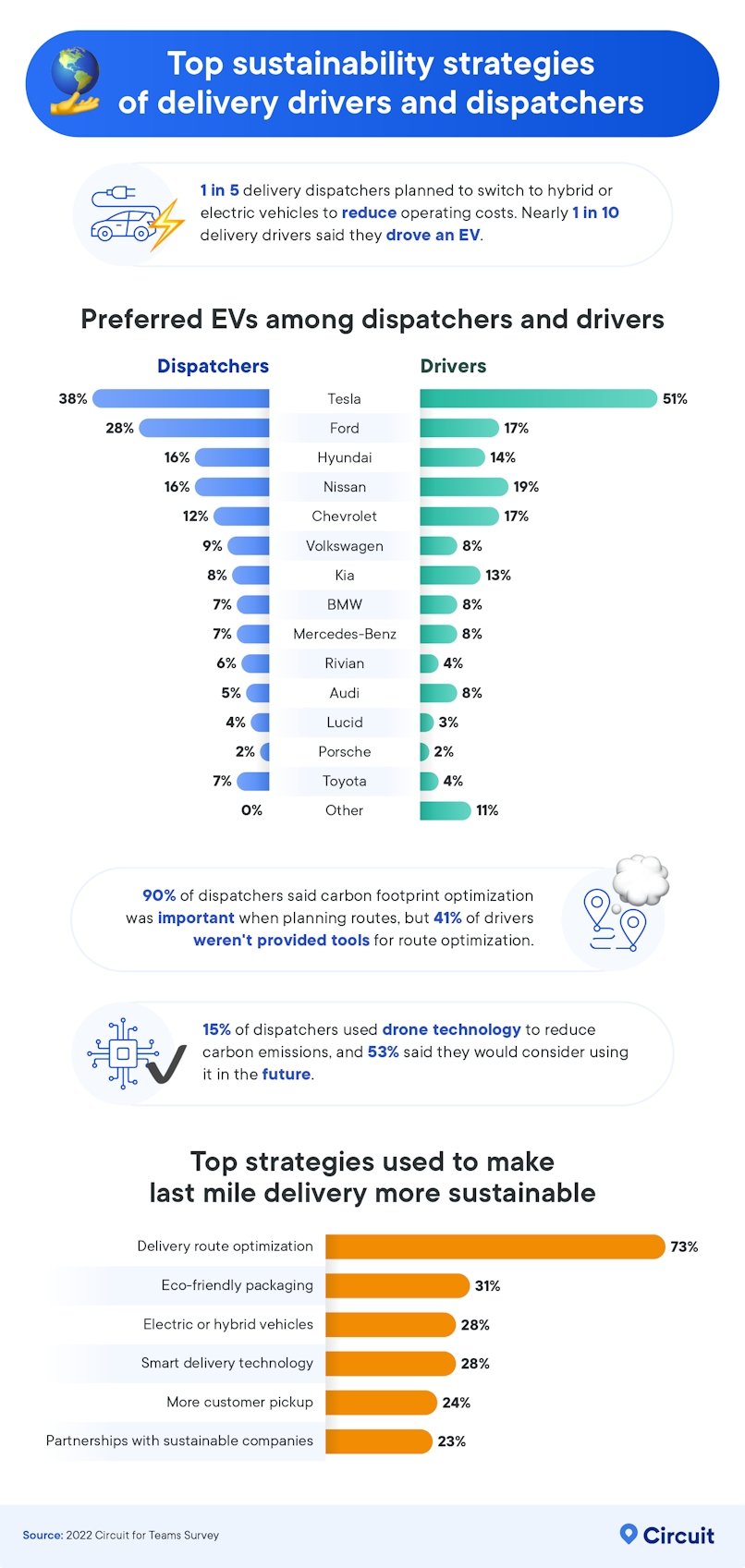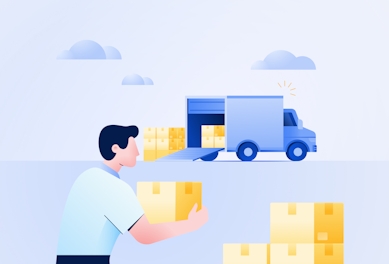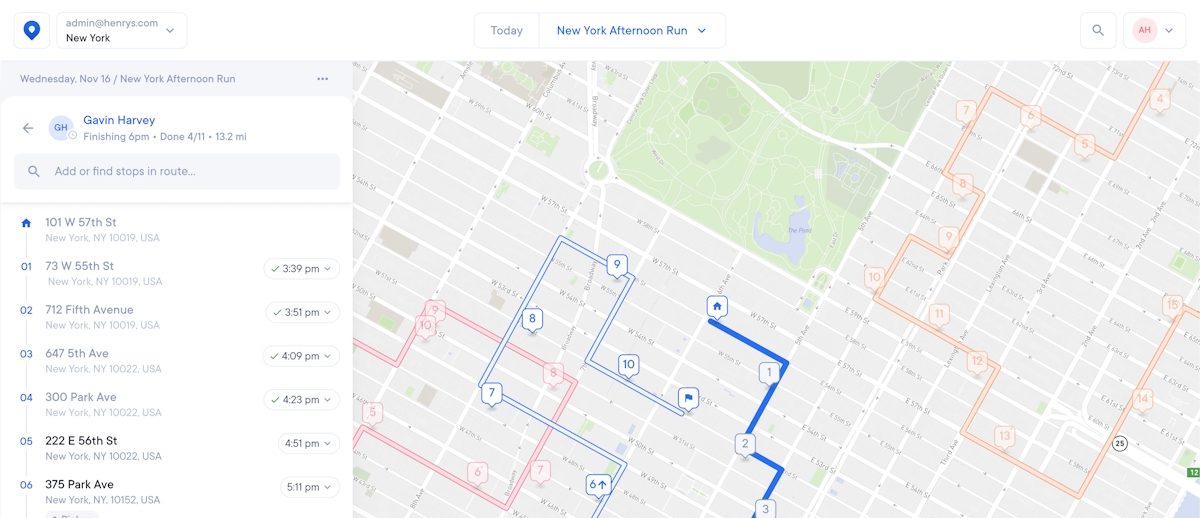Lowering Your Carbon Footprint With Route Optimization
Learn how route optimization can reduce your carbon footprint and save money on fuel to create a sustainable future for your business and the environment.

Use our calculator to determine your current CO2 emissions and find out how route optimization can improve your carbon footprint — and your bottom line.
Key takeaways
- Tesla is the preferred EV among delivery drivers (51%) and dispatchers (38%).
- 15% of dispatchers use drone technology to help reduce carbon emissions, and 53% would consider testing it in the future.
- 90% of dispatchers think carbon footprint optimization is important when planning routes, but 41% of drivers aren’t given route optimization software.
Benefits of a proactive approach to sustainability
Consumers are increasingly aware of environmental issues, intentionally choosing sustainable companies more often when doing business. Companies can enhance their sustainability profile by optimizing last-mile delivery to lower their carbon footprint.
Adopting sustainable practices in delivery can also help companies save money, reduce fuel consumption and vehicle maintenance, and adhere to compliance regulations.
To help you discover how sustainable last-mile delivery can help your business, we talked to more than 1,000 delivery drivers and dispatchers to find out how they’re working to reduce their carbon footprints.
We also created a carbon footprint reduction calculator so you can get an idea of just how helpful route optimization would be in lowering your delivery emissions. Let’s get started.
Carbon footprint calculator points you in the right direction
Shifting business practices to improve sustainability takes some effort, and you want to be sure those efforts will be well worth it.
So, we created a carbon footprint reduction calculator to help you determine the impact of route optimization on your current carbon emissions.
Our calculator uses your current data — number of vehicles, average distance traveled per day, average fuel economy, and fuel type — to determine current monthly and yearly emissions. The calculator then shows what a 20% reduction of emissions would amount to, based on the average savings from route planning optimization.
A 2021 US Energy Information Administration report estimated that there was approximately 1,486 million metric tons in carbon dioxide (CO2) emissions from gasoline and diesel transportation in the United States. Applying a 20% reduction from route optimization would decrease the total to 1,189 million metric tons.
When those numbers are multiplied worldwide, route optimization could drastically reduce global CO2 emissions. The results could be even more substantial when paired with other sustainability efforts.
But route optimization doesn’t only lower carbon emissions; it also lowers fuel consumption, which can significantly cut fuel costs for delivery businesses.
Key takeaway: Efficient route planning can help lower CO2 emissions from delivery vehicles by 20%.
How route optimization helps reduce emissions
Route optimization can help save money and reduce your company’s carbon footprint in the following ways:
- Reduced distance and fuel consumption. By optimizing last-mile delivery routes, businesses can reduce the distance traveled by their delivery vehicles, resulting in less fuel needed to complete the same number of deliveries.
- Reduced idle time. Route optimization can also help reduce idle time for delivery vehicles by avoiding stops and traffic.
- Improved vehicle utilization. Optimizing delivery routes can help businesses make better use of delivery vehicles, maximizing the number of deliveries made by each driver on each trip.
Key takeaway: Route optimization can help last-mile delivery businesses improve fuel efficiency, reduce idle time, and maximize vehicle use.
Dispatchers and delivery drivers are going green
There are several ways delivery businesses can improve sustainability. We surveyed 932 delivery drivers and 109 delivery dispatchers to find out their strategies for becoming more environmentally friendly.

One way dispatchers and drivers are embracing sustainability is by switching to electric vehicles (EVs). One-fifth of dispatchers said they planned to switch to EVs to save money, and approximately 7% of delivery drivers surveyed said they already drove an EV.
When asked about their preferred brand of EV, Tesla ranked No. 1 for 51% of delivery drivers and 38% of dispatchers. Ford ranked second for dispatchers (28%), while Nissan took second place for drivers (19%).
Aside from changing vehicles, route optimization was the top strategy dispatchers used to make last-mile delivery more sustainable. But while 90% of dispatchers said carbon footprint optimization was important, 41% of drivers weren’t given any route optimization tools.
As a result, on average, delivery drivers made seven repeat deliveries to the same location monthly.
Meanwhile, 15% of dispatchers used drone technology to reduce vehicle usage and carbon emissions. Another 53% would consider testing drone technology in the future.
Key takeaway: In addition to route optimization, electric vehicles and drone technology are helping last-mile delivery businesses go green.
Building a sustainable future for the environment and your business
Route optimization can significantly impact the carbon footprint of delivery companies by maximizing truck use and reducing travel time, idle time, and fuel consumption. This not only helps reduce CO2 emissions but can also save your business money.
Additionally, implementing sustainable practices like route optimization and EV use can contribute to your company’s positive image and show your customers a commitment to the environment.
Making a conscious effort to lower your carbon footprint can help your business stand out as a leader in sustainability and help you save money, protect the environment, and earn customer loyalty with every delivery.
Methodology
We surveyed 932 delivery drivers and 109 delivery dispatchers. Of delivery drivers, 72% were food delivery drivers, 17% were package delivery drivers, and 11% were other delivery drivers.
Calculator:
- Multiply average distance per day by number of vehicles in the fleet to get the total distance traveled.
- Convert distance to fuel consumption by dividing total distance traveled by average fuel efficiency to get the total fuel consumption per day.
- Calculate daily carbon emissions using emission coefficient per day.
- Gasoline’s emission coefficient is 19.37; diesel’s is 22.45.
- Multiply gasoline emission coefficient by total fuel consumption per day to get pounds CO2 per day.
- Convert daily carbon emissions to yearly by multiplying by 365; monthly by 30.
- To optimize, reduce the input distance driven by 20%, assuming that route optimization would reduce drive time and distance by 20%.
About Circuit for Teams
Circuit for Teams is committed to helping delivery dispatchers find the best routes for their drivers while saving money and reducing emissions. Easily optimize delivery routes, track your drivers, and keep customers up to date with our route planning software.
Fair use statement
We encourage you to share this calculator and our findings with other green-minded businesses for any noncommercial purpose. We just ask that you link back to this page so they can access our full report and methodology.




